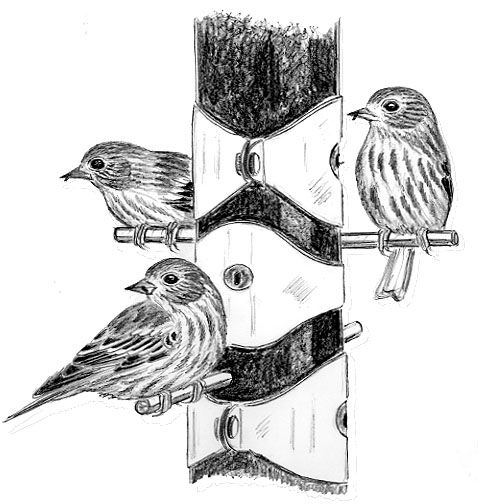
Dear Bird Folks,
This winter I have a flock of birds in my yard that I can’t identify. Every morning at least a dozen of these mystery birds invade my thistle feeder. They look like they are part goldfinch and part sparrow. If there weren’t so many of them, I’d be inclined to think they are some kind of hybrid. If you know what this bird is, please enlighten me.
– Dora, Millbury, MA
I think I know, Dora,
You say you live in Millbury, MA and see a bird that looks like a hybrid of a sparrow and finch, eh? Hmm. The only bird it can be is a spinch, half sparrow and half finch. My grandfather grew up in Millbury and used to tell me that during certain winters flocks of spinches would swarm his feeders. I’ve never seen a spinch myself and always thought that he was making them up, but apparently they are real birds. Old grandpa was telling the truth. Well, I’ll be a son of a spinch.
Of course, I’m only kidding. My grandfather wasn’t from Millbury. Actually, he really did live in Millbury, Dora. He had gray hair and glasses. Did you know him? However, the birds that have invaded your feeders aren’t spinches. They are Pine Siskins. Like you said, siskins do have striped brown bodies, like some sparrows do. Plus, they have some yellow streaking, a finch-shaped body, and an odd pointy bill, which is different than the beak of either bird.
I’m not surprised you have so many siskins in your yard. They are extremely social birds and are constantly in the company of each other, even during nesting season. They don’t bother wasting time and energy defending breeding territories. If another pair of siskins wants to build a nest next door, they are totally cool about it. They don’t even mind if other siskins want to stop by their nest for a visit. The coffee is always on at the siskin home. These birds will even feed each other. Many people get all warm and fuzzy when they see a male cardinal feed a female. Siskins take this bonding activity one step further. To keep the flock tight a male siskin may pass food to a female, but he may also pass food to another male. And they’ll exhibit this same-sex feeding behavior no matter where they are, not just in Massachusetts.
For all their chumminess siskins can turn nasty in a hurry. Just try to move one off a feeder and see what happens. It will rip your face off, or at least it will if you are a bird. If another bird, big or little, tries to push a siskin off a feeder, the feisty siskin will lower its head, flair out its wings and chirp: “Back off!” If that doesn’t get the job done, then the little finch/sparrow will lunge at the usurper, using its sharp bill to get the “point” across.
In the eastern half of North America most Pine Siskins live around the Canadian border. They are typically associated with a particular type of tree. Exactly which type of tree that is I’m not sure, but my guess is that it’s probably a pine. Every few years pine trees, along with other trees, don’t produce a large crop of seeds. When this happens tens of thousands of these little birds abandon their usual range and push south to invade our feeders. Yea!
There once was a time when it was thought that low seed production had to do with drought, bad weather, or some other environmental factor. Now treeologists tell us that the trees produce bad crops on purpose. Yes, on purpose. They claim that if trees have a bumper crop every year then the creatures that ate the trees’ seeds would become overly abundant. Eventually, the hungry creatures would strip the trees of all their seeds and none would be available to rebuild the forest. In order to survive, the trees got together and agreed to occasionally have a lean year or two. Lean years cause many seed-eating creatures to starve, which knocks their population back and allows the trees to regenerate. Who would have guessed that trees were so sinister?
For a bird watcher, one of the frustrating things about Pine Siskins is trying to forecast when the invasions of these little birds will occur. A shortage of seeds in the north does not guarantee that we’ll have flocks of siskins visiting our yards. The behavior of these birds is harder to predict than the stock market. While hummingbirds tend to stop in the same towns, at the same yards, and visit the same feeders each year, siskins follow no set pattern. The birds that are visiting your feeders in Millbury, MA this winter may spend another winter in Altoona, PA. A siskin’s search for food is like my wife’s attempt to drive to Logan Airport. It is anyone’s guess where either will end up.
Enjoy your siskins, Dora. They are fun birds to see. I only wish they would visit us more often because those little birds sure can eat. When siskins invade our area my thistle seed sales triple. While some people think siskins look like sparrows, and others think they look like finches, to me they look like flying dollar signs.